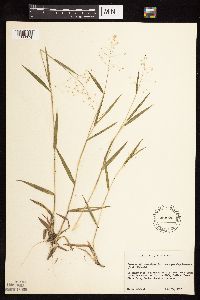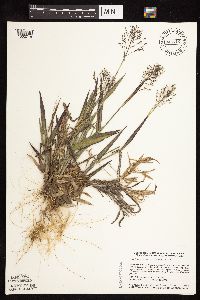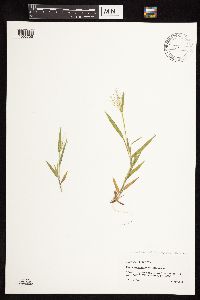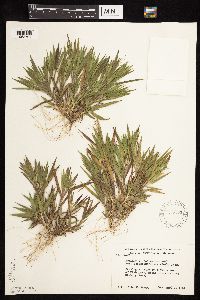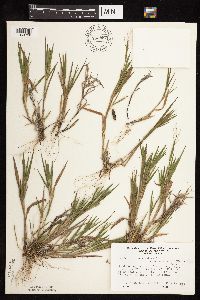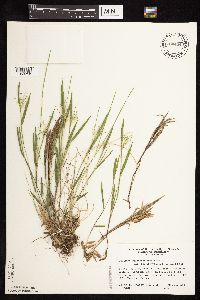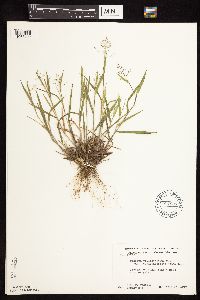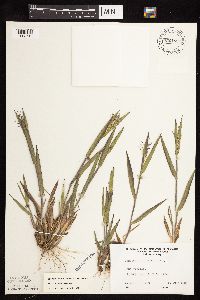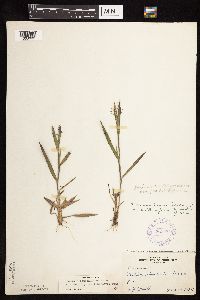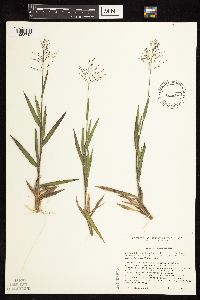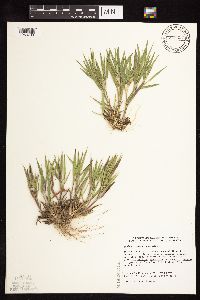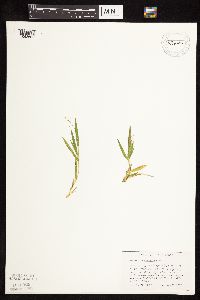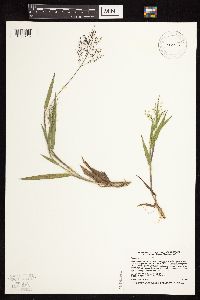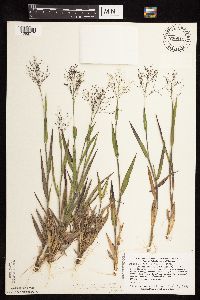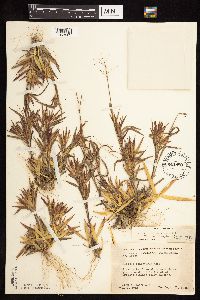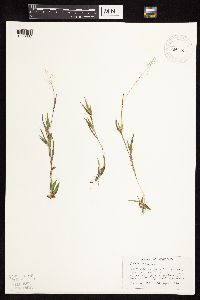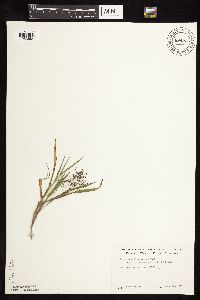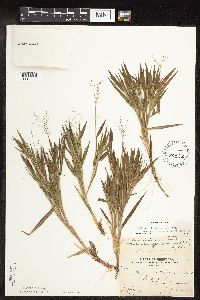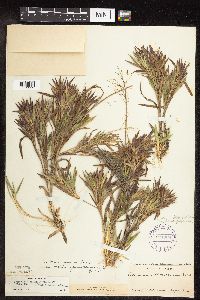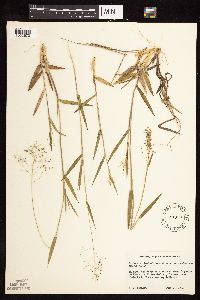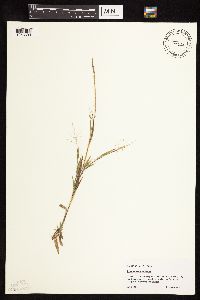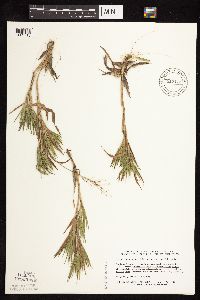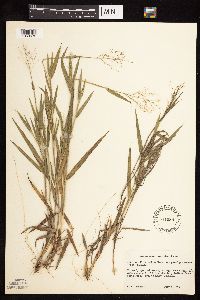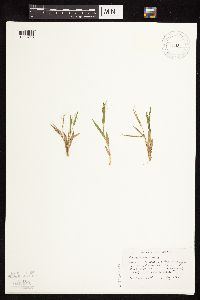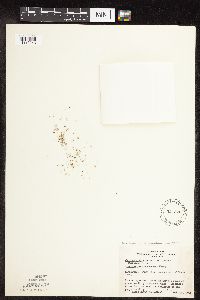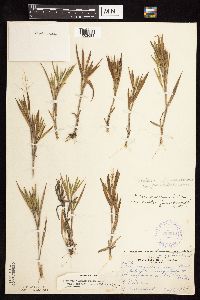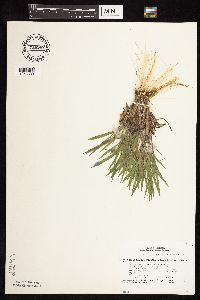Dichanthelium ovale subsp. pseudopubescens
|
|
|
|
Family: Poaceae
Egg-Leaf Witch Grass
|
Basal blades 2-6 cm, evenly pilose. Culms more than 1 mm thick, stiff; lower internodes sparsely pubescent, with ascending or appressed hairs, hairs shorter than 4 mm, not papillose-based. Cauline sheaths with sparse, ascending or appressed hairs, hairs shorter than 4 mm, often with shorter hairs underneath, not papillose-based; ligules 1-4 mm; blades 3-8 mm wide, both surfaces sparsely appressed-pubescent, margins ciliate basally, scabridulous elsewhere. Spikelets 2.1-2.6 mm, ellipsoid or obovoid-ellipsoid, with papillose-based hairs. Dichanthelium ovale subsp. pseudopubescens grows in dry, sandy, open woods, sandhills, and sand dunes, over the same geographic range and in the same habitats as subsp. villosissimum, and often intergrades morphologically with that subspecies. Perennial herb, tufted 15 cm - 0.6 m tall Inflorescence: a terminal, branched arrangement of spikelets (panicle). Primary panicles atop the culms, 3 - 10 cm long, almost as wide when fully open. Secondary panicles (when present) atop the branches. Fruit: a caryopsis, indehiscent, enclosed within the persistent lemma and palea. Culm: stiff, mostly spreading or ascending, 15 cm - 0.6 m long, over 1 mm thick, round in cross-section, hollow, sparsely hairy on lower internodes with appressed or ascending hairs that are less than 4 mm long. Nodes sparsely to densely bearded. Fall phase with decumbent to prostrate culms, forming dense clusters of branches that have upright, slightly reduced leaf blades and highly reduced secondary panicles. Spikelets: 2 - 2.5 mm long, ellipsoid to reverse egg-shaped with a blunt to nearly pointed apex, with bumpy-based hairs. Basal leaves: in a rosette. Blades 2 - 6 cm long, lance-shaped, distinct from the stem blades, softly hairy. Stem leaves: four to seven, alternate, two-ranked. Sheaths shorter than internodes, sparsely hairy with appressed or ascending hairs that are less than 4 mm long. Ligules 1 - 4 mm long, composed of hairs. Blades relatively firm, spreading or ascending, distinctly longer and narrower than basal leaves, 4 - 10 cm long, 3 - 8 mm wide, lance-shaped with a rounded or slightly narrowed base, parallel-veined, sparsely appressed-hairy, marginally whitish and minutely rough, fringed with hairs basally. Glumes:: Lower glumes one-third to one-half as long as spikelets, triangular with a more or less pointed apex, veined (not strongly). Upper glumes a bit shorter than lower lemmas and upper florets when mature, veined (not strongly). Lemmas:: Lower lemmas similar to upper glumes. Upper lemmas longitudinally lined, shiny, with rolled-up margins above. Paleas:: Lower paleas shorter than lower lemmas, thin. Upper paleas longitudinally lined. Florets:: Lower florets sterile. Upper florets bisexual, stalkless, 1.5 - 2.5 mm long, a bit less than half as wide as long, ellipsoid with a nearly pointed apex, plump. Anthers three. Stigmas red. Similar species: No information at this time. Flowering: late May to early July Habitat and ecology: Very common in dry sandy Black Oak savannas. It is a characteristic plant of small blowouts in dune areas. Occurence in the Chicago region: native Etymology: Dichanthelium comes from the Greek words di, meaning twice, and anth, meaning flowering, referring to plants that may have two flowering periods. Ovale means oval. Pseudopubescens means "mistaken for Panicum pubescens." Author: The Morton Arboretum From Flora of Indiana (1940) by Charles C. Deam As now known, this species is restricted to the northwestern counties. Further study will doubtless extend its range to a few adjoining counties. It grows in very dry, sandy soil in the open on knolls, dunes, and ridges, where it is usually associated with black and white oak. ...... Treated as a distinct species, D. commonsianum, by J. Thomas (2015). Although most frequent in the northwestern counties, but is also known from Cass, Lagrange, Marshall, and Stueben Counties. Indiana Coefficient of Conservatism: C = 6 Wetland Indicator Status: FACU According to the treatment by Justin Thomas (2015) our Indiana specimens should be called D. commonsianum. |



